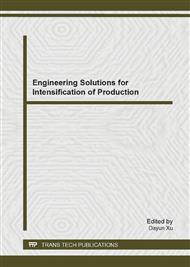[1]
Schaf ter R E Yurkow sky W, Fink elstein J M. Accelerated testing technology [J]. Technical Report NO. RADC-TR-67-420, 1967: 1-2.
Google Scholar
[2]
SHU Xiumei,ZHANG Shifu,LIU Tianmin,LUO Yuanyuan. A Brief Review of Accelerated Life Testing Research [J]. Journal Of Logistical Eegineering University 2012, 28 (6): 44-50.
Google Scholar
[3]
Song Yanan,Li Xinjun,Liu Xuefeng,Zhang Shinian,Wang Shouzhen. A Review of Accelerated Storage Life Testing [J]. Electronic Product Reliability and Environment Testing, 2009, 51: 189-192.
Google Scholar
[4]
Wang Lingling Mao Shisong. Accelerated Life Testing [M]. Beijing: Science Press, (2000).
Google Scholar
[5]
Nelson W B. Accelerated testing: statistical models, test plans, and data analyses[M]. New York: John Wiley & Sons, Inc, (1990).
Google Scholar
[6]
Mao Shisong,Tang Yincai,Wang Lingling. Reliability Statistics [M]. Beijing: Higher Education Press, (2008).
Google Scholar
[7]
Chen Wenhua, Feng Hongyi, Qian ping. Theory & Method for Optimum Design of Accelerated Life Test Plan under Multiple Stresses [J]. Mechanical Engineering, 2006, (12).
DOI: 10.3901/jme.2006.12.101
Google Scholar
[8]
Zhao Sijun,Wang Shaoping,Shi Jian,Li Lan. Development of Accelerated Life Test [A]. In: Robotics, Automation and Mechatronics [C]. chengdu: (2008).
DOI: 10.1109/ramech.2008.4681467
Google Scholar
[9]
Watkins A.J. Review. likelihood method for fitting Weibull log-linear models to accelerated life-test data [J]. IEEE Transactions on Reliability, 1994, 43 (3): 361-365.
DOI: 10.1109/24.326426
Google Scholar
[10]
Bugaighis M.M. Exchange of Censorship Types and its Impact on the Estimation of Parameter of a Weibull Regression Model [J]. IEEE Transactions on Reliability, 1995, 44 (3): 496-499.
DOI: 10.1109/24.406590
Google Scholar
[11]
Wang YaShun. Research of Simulation-based Optimal Design for Accelerated Testing [D]. Changsha: National University of Defense Technology, (2008).
Google Scholar
[12]
Liu Lixi,Ge Guangping. Optimum Step-Stress Accelerated Life TestS With Competing Cause of Failure under Exponential Distribution [J]. Applied Probability and Statistics, 1998, 14 (3): 301-306.
Google Scholar
[13]
Zhang Zhihua. Comparison of Optimum Accelerated Life Tests [J]. Applied Probability and Statistics, 2001, 17 (3): 303-307.
Google Scholar
[14]
TAN Yuanyuan, ZHANG Chunhua, WANG Yashun, CHEN Xun. Study on Simulation Based Optimal Design Method for Accelerated Testing with Competing Failure Modes [J]. Journal Of National University of Defense Technology, 2011, 33 (2): 130-135.
Google Scholar
[15]
ZHANG Fang, CAI Jinyan. Optimization Design of Step-Stress Accelerated Life Test with Competing Risks [J]. Electronics Optics & Contro l, 2011, 18 (1): 94-97.
Google Scholar
[16]
WANG Yashun, ZHANG Chunhua, CHEN Xun. Study of Simulation Based Optimal Designs for Accelerated Life Testing [J]. Journal of Astronautics, 2006, 27 (4): 755-760.
Google Scholar
[17]
Pan Gang. Optimal Design of Reliability Accelerated Test Based on Simulation [D]. Shijiazhuang: Ordance Engineering College, (2012).
Google Scholar
[18]
Zhang Chunhua , Wen Xisen , Chen Xun. A Comperhensive Review of Accelerated Life Testing [J]. Acta Armamentarii, 2004, 25 (4): 485-490.
Google Scholar


